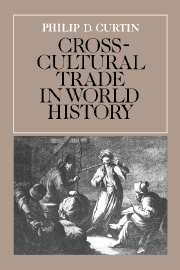Book contents
- Frontmatter
- Contents
- List of illustrations
- Preface
- 1 Trade diasporas and cross-cultural trade
- 2 Africa: incentives to trade, patterns of competition
- 3 Africa: traders and trade communities
- 4 Ancient trade
- 5 A new trade axis: the Mediterranean to China, circa 200 B.C. – A.D. 1000
- 6 Asian trade in Eastern seas, 1000–1500
- 7 The European entry into the trade of maritime Asia
- 8 Bugis, banians, and Chinese: Asian traders in the era of the great companies
- 9 Overland trade of the seventeenth century: Armenian carriers between Europe and East Asia
- 10 The North American fur trade
- 11 The twilight of the trade diasporas
- Bibliography
- Index
5 - A new trade axis: the Mediterranean to China, circa 200 B.C. – A.D. 1000
Published online by Cambridge University Press: 15 March 2010
- Frontmatter
- Contents
- List of illustrations
- Preface
- 1 Trade diasporas and cross-cultural trade
- 2 Africa: incentives to trade, patterns of competition
- 3 Africa: traders and trade communities
- 4 Ancient trade
- 5 A new trade axis: the Mediterranean to China, circa 200 B.C. – A.D. 1000
- 6 Asian trade in Eastern seas, 1000–1500
- 7 The European entry into the trade of maritime Asia
- 8 Bugis, banians, and Chinese: Asian traders in the era of the great companies
- 9 Overland trade of the seventeenth century: Armenian carriers between Europe and East Asia
- 10 The North American fur trade
- 11 The twilight of the trade diasporas
- Bibliography
- Index
Summary
In the last half-millennium before the Christian era, zones of intercommunication like the Hellenistic world began to develop elsewhere in the Afro-Eurasian landmass. On the Indian subcontinent, a new cultural synthesis had been in the making for centuries, built on elements of the older civilization of the Indus valley, local traditions elsewhere in India, and the cultural contributions of the Aryan-speaking invaders who came across the northwestern frontier during several centuries centered on 1500 B.C. or thereabouts. Buddhism, a new religion drawing on older Brahman religious traditions, was one of the main articulating elements in this new synthesis. It began spreading through the subcontinent from the time of the Buddha himself in the fifth century B.C. The Maurya Empire, reaching its apogee in the reign of Ashoka in the third century B.C., unified most of the South Asian world and guaranteed a broad, if temporary, victory for Buddhism as a religion. More important still, it helped to create a political framework for a common culture that began to be recognizably Indian in spite of great regional variation.
Still farther east, Confucius's teachings of the fifth century B.C. had their first political expression in the Han dynasty of China (ca. 206 B.C. to 220 A.D.), which united China for the first time and helped to integrate various local cultures in much the same way the Maurya and Hellenistic syntheses had done farther west.
Up to about the second century B.C., these centers had been separated by mountains, steppe, desert, and deep forests with very sparse populations. Overland contact was possible, but occurred only occasionally.
- Type
- Chapter
- Information
- Cross-Cultural Trade in World History , pp. 90 - 108Publisher: Cambridge University PressPrint publication year: 1984
- 1
- Cited by



